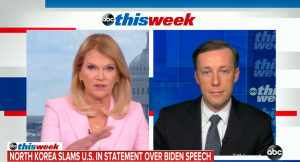North Korea: Keeping Its Powder Dry
What to Make of Recent North Korean Statements

There are signs that Washington and Pyongyang are in the early, cautious stages of a diplomatic dance. On April 30, White House Press Secretary Jen Psaki revealed that the administration had completed its North Korea policy review. Pyongyang has so far remained silent on Psaki’s statement. However, on May 2, though they had doubtless read Psaki’s remarks, the North Koreans decided to hold off commenting on the review and instead issued a muted response critical of President Joseph Biden’s brief mention of the North in his April 28 address to Congress.
Three key points demonstrate an effort by the North to signal that it wasn’t going to ignore the president’s singling out the North as a “threat” in his first address to the Congress, but in a carefully calibrated way:
- The reaction to the president’s remarks was in the name of Director General for American Affairs Kwon Jong Gun rather than in a statement at a more authoritative level. Confining the response to Kwon’s level gives Pyongyang room to respond differently and more authoritatively at a later time.
- Kwon’s comments did not include any personal attacks on the president or refer to him by name.
- The statement’s bottom line was a vaguely formulated threat wrapped in uncertain timing: “…we will be compelled to press for corresponding measures, and with time the U.S. will find itself in a very grave situation.” Moreover, the threat of DPRK action was braked by an important conditional—“if” the US still held to an outdated perspective, it would face a “worse and worse crisis beyond control.”
National Security Adviser Jake Sullivan’s remarks on a May 2 Sunday morning talk show, coming on the heels of Kwon Jong Gun’s statement, could suggest to the North that Washington was in a similarly cautious mode, and was not going to be distracted by low-level criticism from Pyongyang. Moreover, Sullivan’s language describing a “calibrated, practical, measured approach” could strike Pyongyang as similar to language it was using in 2018 to illustrate its ideas and is likely a welcomed overture.
For now, though, North Korea appears to be waiting for a fuller public presentation of the policy review before responding. Meanwhile, what might have some people in Pyongyang sitting up in their chairs and contemplating the next move is the April 30 Washington Post article that cited a senior administration official as saying that the administration would “build on” the June 2018 Singapore agreement.
At the Eighth Workers’ Party Congress in January, Kim Jong Un’s work report made clear that he considered the Singapore Joint Statement still the basis for a “new” US-DPRK relationship.[1] Pyongyang has undoubtedly been waiting to see if the new administration—in what has become the mark of US presidential transitions—would discard Singapore or keep it in play. Given Kim’s personal connection with the June 2018 statement, upholding it could be a crucial factor in guiding the North’s next steps.
It would not be a surprise if both sides use this initial period to probe and posture a bit. Prior to edging into the next stage, the North Koreans almost certainly will want to be seen as remaining suspicious and unconvinced that the US has abandoned its “hostile policy,” and that they are as threatened by the US as the US says it is by the North.
- [1]
“On Report Made by Supreme Leader Kim Jong Un at 8th Congress of WPK,” KCNA, January 9, 2021.
